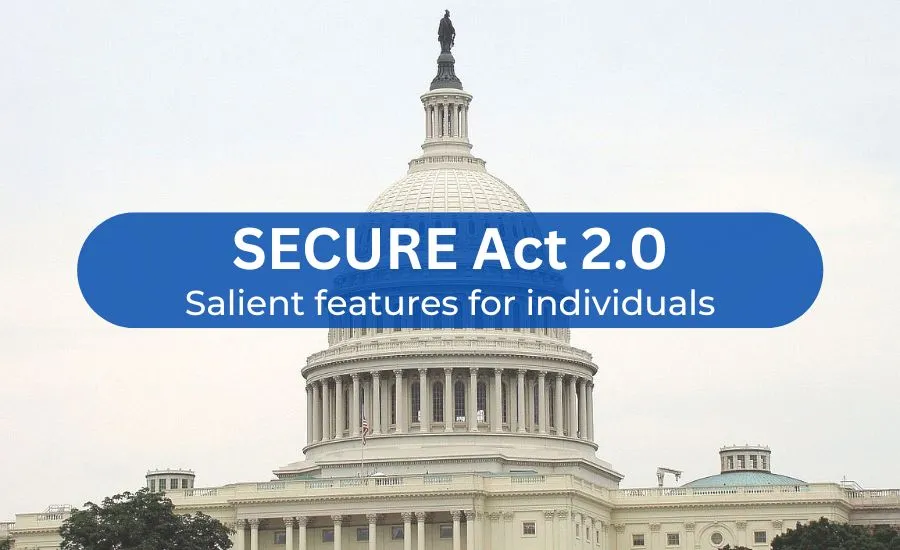The SECURE Act 2.0 contains a number of significant features that affect individual retirement savers. The following is a summary of various significant changes.
It’s finally time for SECURE Act 20. The Setting Every Community Up for Retirement Enhancement (SECURE) Act, which was passed in 2019, received a long-awaited improvement on December 29, 2022, when it was officially signed into law. The SECURE Act 2.0 contains a number of major features that affect individual retirement savers. The following is a summary of various significant changes.
RMD age increase: In general, participants in eligible retirement plans such as 401(k)s and IRAs must begin taking required minimum distributions (RMDs) when they reach the age of 72. The first SECURE Act raised this age limit from 7012 to 7012. SECURE Act 2.0 raises the retirement age to 73, commencing in 2023. Even better, in ten years, the age limit will be raised to 75 in 2033.
Reduced RMD penalty: If you don’t withdraw an RMD by the due date, you risk a harsh tax penalty equal to 50% of the amount that should have been withdrawn (minus any amount actually withdrawn). The new law reduces the penalty to 25% of the deficiency for tax years commencing after the date of enactment. It may even be reduced to 10% if the omission is corrected immediately.
Penalty-free emergency distributions: Unless a special exception occurs, distributions from a retirement plan or IRA are usually subject to a 10% penalty on top of regular income tax. Beginning in 2024, you can withdraw up to $1,000 per year from a retirement account without penalty to fulfill certain financial requirements. However, if you repay the distribution within a defined time frame, you will be allowed to receive another for three years.
Greater catch-up: Payments are permitted under the tax code if you are 50 years of age or older, subject to an annual cap. Beginning in 2025, the new law raises the ceiling for these additional contributions from $7,500 to the greater of $10,000 or 50% of the current catch-up limit if you are between the ages of 60 and 63. (indexed for inflation). Other increases apply to IRA and SIMPLE plan catch-up contributions.
Catch-up payments to a Roth 401(k): With a Roth 401(k) plan, you make contributions with after-tax money, but future distributions are often tax-free. If you earn more than $145,000 per year, the new law mandates you to make catch-up payments to your 401(k) to Roth accounts (indexed for inflation). Beginning in 2024, these accounts will no longer be obliged to take lifetime RMDs.
New retirement saver’s credit: Some employees may be eligible for a retirement saver’s credit if they contribute to a qualified plan or an IRA. The new law substitutes a matching contribution from Uncle Sam, up to $2,000, equivalent to 50% of the amount you put to your retirement account, for this credit. There are some income limitations and a phase-out rule that apply.
QCDs have a special rule: Anyone 7012 or older can currently make a qualified charitable contribution (QCD) that sends $100,000 directly from an IRA to a charity without incurring any tax repercussions. Beginning in 2023, you can add a one-time donation of up to $50,000 to a charitable remainder trust or charitable gift annuity in a QCD. This a quick reminder that a QCD counts toward your RMD responsibilities.
Rollovers from a 529 account to an IRA are permitted: A child’s higher education expenses may be covered by a Section 529 plan that you fund. Starting in 2024, monies from a Section 529 account that have not yet been used can be transferred tax and penalty-free into a Roth IRA up to a lifetime cap of $35,000. The 529 accounts must have been active for at least 15 years.
The tax laws are very complex. Our short blog articles cannot cover in full all the nuances of the rules. Your specific facts may hold various opportunities and possible risks that only trained, experienced, and highly qualified tax specialists can spot. We encourage you to find such help, rather than trying to figure it all out on your own. Consider giving this marketplace a try by posting your project and signing up here.
If you are a licensed tax professional interested in helping others either part or full-time, or ad hoc, come on in! Happy to have you. Our marketplace has the full suite of tools to communicate with clients including compliance calendars, task and message management, and billing. You can also quickly connect to knowledgeable colleagues who can complement your services with the ones you do not provide. Register here.









1 Comment
The SECURE Act 2.0's salient features for indiv...
[…] The SECURE Act 2.0 contains a number of significant features that affect individual retirement savers. […]